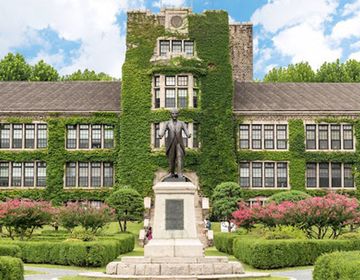Visiting the National Museum of Korean Contemporary History in Seoul
Today we visited the National Museum of Korean Contemporary History. The museum has many floors with different exhibits, but I visited the History Gallery. The History Gallery had three parts covering major events in the last hundred and thirty years. The first part from 1894 to 1945 covers the Japanese Colonization of Korea and resistance efforts of the Korean people, which started the formation of a Korean national identity. The second part from 1945 to 1987 covers liberation, the Korean war, and the adoption of democracy. The third part from 1987 to 2022, covers issues on North and South Korea, as well as Korea’s place is a globalizing world and the Hallyu wave.
We were provided with English audio recording that walked us through each display in the museum. I found this extremely helpful since the recording would explain the significance of each artifact on display as well as the general history of the time period. The exhibits were very informational and it was really cool to see artifacts in person. I was extremely impressed by how many resistance movements were started and supported by students, farmers, and women. This was my first time hearing about the struggles of the Korean Language Society to safeguard the Korean language during the Japanese occupation. I am glad I got to see the first Korean dictionary in person and am looking forward to learning more about events surrounding the standardization and preservation of the Korean language.
Although many of the exhibits talked about terrible tragedies and hardships faced by the people, there were also many wonderful and inspirational stories that give viewers hope in working towards a brighter future. From the rooftop viewing deck of the museum, I was able to look out at the sprawling city of Seoul with countless skyscrapers build around the Gyeongbokgung Palace complex with the steep green mountains emerging in the distance. Reflecting on the struggles of the Korean people over the past 100 years while taking in the view was truly an emotional moment.
But don’t stop just yet! Outside the museum is Gwanghwamun plaza which has the iconic statue of King Sejong the Great, creator of Hangul, the Korean alphabet, with several of his other inventions including the Armillary Sphere, the Rain Gauge, and the Celestial Globe. There is also a statue of Admiral Yi Sun-sin who is one of the most famous naval commanders and who defended Korea from Japanese warships during the Imjin War.
I would definitely recommend spending an afternoon at the museum. More information can be found at the National Museum of Korean Contemporary History.
Related Posts
K-Pop Stan’s Guide to South Korea: 5 Must-Do Activities While Studying Abroad
By: Jacqueline Lee South Korea is the place to be as a kpop stan, so here are 5 activity ideas that you must do during your time abroad! 1. Collect... keep reading
Courses at Yonsei University—Difficulty, Planning & Advice!
If you're curious about the difficulty of college courses in South Korea, as well as course planning and advice, then this article is for you. In this blog, I delve into my courses at Yonsei University and offer helpful advice for course planning—tune in to learn more!
Fitting in with locals when you can’t speak the language
By: Raphael Li Coming to Seoul, there are so many different experiences you can have even as an exchange student. Some people make only exchange/international friends. Some students make many... keep reading







